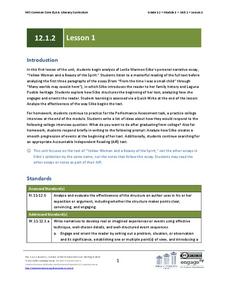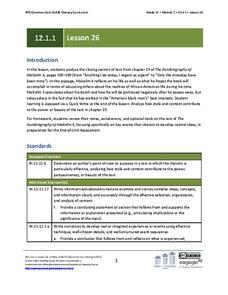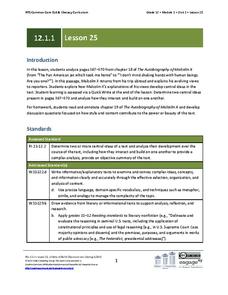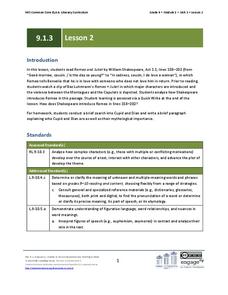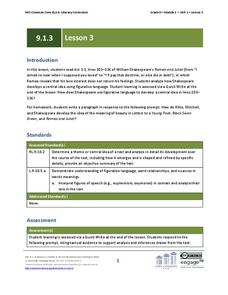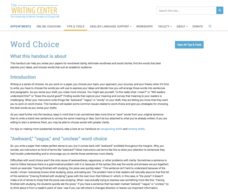EngageNY
Grade 9 ELA Module 4, Unit 1, Lesson 6
How do writers create a specific tone in their text? As class members continue their study of Sugar Changed the World, they focus on the words and phrases that Aronson and Budhos use to create that tone in their descriptions of arduous...
EngageNY
Grade 9 ELA Module 4, Unit 1, Lesson 8
In a close reading of "The Overseer" chapter from Sugar Changed the World, groups focus on the words Aronson and Budhos use to contrast the lifestyles of enslaved people and their enslavers. The whole class then engages in an...
EngageNY
Grade 9 ELA Module 4, Unit 1, Lesson 11
As part of a study of how writers structure their text so that readers understand events, class members do a close reading of "Is It Lawful to Make Slaves of Others Against Their Will?" a chapter in Aronson and Budhos' Sugar Changed the...
EngageNY
Grade 9 ELA Module 4, Unit 1, Lesson 19
Building on the previous discussion of the supplemental reading article "Where Sweatshops Are a Dream," class members use the provided Evaluating Argument and Evidence Tool to identify the claims and evidence Nicholas Kristof uses to...
EngageNY
Grade 9 ELA Module 4, Unit 1, Lesson 15
The Haitian Revolution takes center stage as class members analyze a passage from Sugar Changed the World and consider how the authors select, present, and organize events to show how the tensions between the concerns for freedom and...
EngageNY
Grade 9 ELA Module 4, Unit 1, Lesson 5
What did the Crusades and plantations do with the global sugar spread? As class members continue their study of Sugar Changed the World, they examine how Crusaders brought sugar to Western Europe and how cultivating sugar led to the...
EngageNY
Grade 12 ELA Module 1, Unit 2, Lesson 1
As part of a study of narrative writing, class members analyze how Leslie Marmon Silko structures the beginning and orients and engages readers in her narrative, "Yellow Woman and a Beauty of the Spirit."
EngageNY
Grade 12 ELA Module 1: Unit 1, Lesson 28
After discussing Haley's techniques in his conclusion of The Autobiography of Malcolm X, class time is devoted to drafting, sharing, and getting feedback on writers' college essays.
EngageNY
Grade 12 ELA Module 1, Unit 2, Lesson 3
How does an author sequence events in a narrative so that the events build on one another and create a tone of mystery, growth, or resolution? As part of a study of narrative writing, class members work in pairs to examine the techniques...
EngageNY
Grade 12 ELA Module 1: Unit 1, Lesson 26
Readers use their annotations and questions about chapter 19 of The Autobiography of Malcolm X to guide their discussion of the final chapter of the text.
EngageNY
Grade 12 ELA Module 1: Unit 1, Lesson 25
Class members return to the discussion of The Autobiography of Malcolm X using the questions they developed and their annotated notes of the events in chapter 17.
EngageNY
Grade 12 ELA Module 1: Unit 1, Lesson 23
Malcolm X's journey to Cairo, his Hajj, his Letter from Mecca detailing his insights into "true Islam," and his transition to Al-Hajj Malik El-Shabazz are the focus of the discussion of chapter 17 of The Autobiography of Malcolm X.
EngageNY
Grade 12 ELA Module 1: Unit 1, Lesson 11
Chapter 10 of Malcolm X's Autobiography introduces readers to Elijah Muhammad's teachings. Discussion questions focusing on syntax and diction draw attention to how Malcolm X's perspective on Mr. Muhammad changes.
EngageNY
Grade 12 ELA Module 1: Unit 1, Lesson 2
After discussing the narrative structure, intended audience, and purpose of Chapter 1 of The Autobiography of Malcolm X, class members draft their statement of purpose for a Common College Application prompt that distinguishes them from...
Curated OER
What is a Metaphor?
The use of metaphors really paints a picture in the reader's mind. Get your class using metaphors in their writing by studying them first. This worksheet has four simple metaphors, and the reader must identify which two things are being...
EngageNY
Grade 10 ELA Module 1: Unit 3, Lesson 4
Vivid quotes and strong sensory language compose Amy Tan's The Joy Luck Club, bringing the women to life as they navigate through issues surrounding identity and maternal relationships. Examine Waverly's relationship with her mother...
EngageNY
Grade 9 ELA Module 1: Unit 3, Lesson 2
After viewing a clip from Baz Luhrmann’s Romeo + Juliet in which major characters are introduced, and the violence between the Montagues and the Capulets is depicted, the class reads Act 1, Scene 1, lines 158-202. Groups then analyze the...
EngageNY
Grade 9 ELA Module 1: Unit 3, Lesson 3
Class members listen to a masterful reading of Act 1, Scene 1, lines 203-236 of Romeo and Juliet and then break into groups to examine how Shakespeare uses figurative language to develop Romeo's idealized concept of beauty.
University of North Carolina
Word Choice
Words matter, particularly in academic writing. Issues such as vague language, wordiness, and cliches make it difficult to get a point across. Part of a larger series to improve writing skills, the handout on word choice shows writers...
EngageNY
Analyzing Word Choice: Atticus’s Closing Speech (Chapters 20-21)
Choose your words carefully. Scholars begin by reading a line of Atticus's closing speech in To Kill A Mockingbird. Readers work independently on their note catchers, then complete a Think-Pair-Share activity with partners. They finish...
EngageNY
Grade 12 ELA Module 1, Unit 2, Lesson 4
The fourth instructional activity in this narrative writing unit focuses on how Leslie Marmon Silko uses telling details and sensory language in her "Yellow Woman and a Beauty of the Spirit" to bring alive the people of Laguna Pueblo and...
Education Closet
West Side Shifts
Combine math, language arts, music, and dance with an activity focused on "America" from West Side Story. After listening to the song, learners compare the film to Romeo and Juliet, analyze the song's meter, design choreography, plan...
Lakeshore Learning
Winter Bear Warm-Up
Don't be left out in the cold, ensure young learners are prepared for the winter weather with this clothing activity. After introducing them to different clothing items using the provided picture cards, students sing a song before...
K12 Reader
In Danger of Extinction
What happens when a species becomes extinct? Sharpen your reading skills with a passage about how koalas have gotten close to being an endangered species.
Other popular searches
- English Language Arts Skills
- Language Arts Skills Review
- &Quot Language Arts Skills
- Process Skills Language Arts
- Life Skills Language Arts
- Esl Language Arts Literacy
- &Quot; Language Arts Skills








